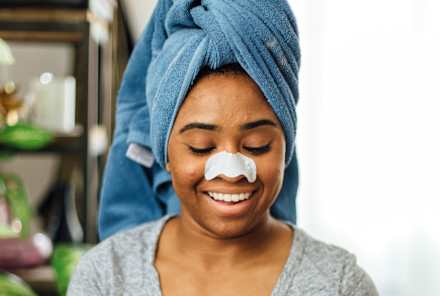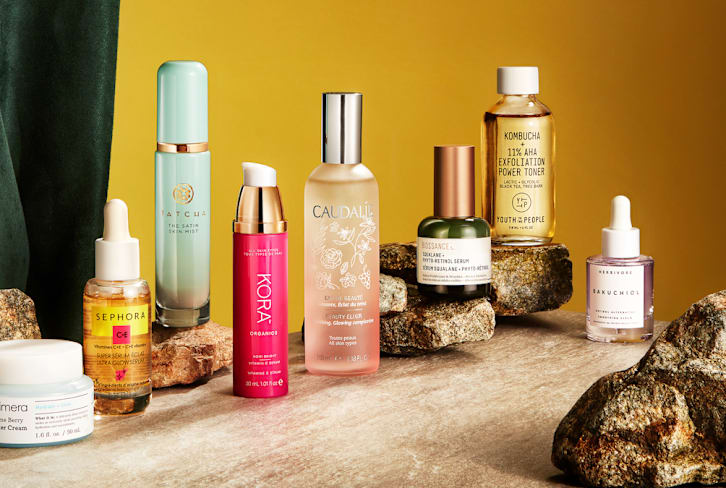Advertisement

Hyaluronic acid—it sounds like an ingredient you'd stress about spilling during a high school chemistry class, but it's actually the opposite of stress-inducing. Hyaluronic acid (HA for short) is a compound our bodies make on their own that boasts all kinds of potential health benefits, from helping our joints and eyes to giving skin a beautiful glow. Here's everything you need to know about hyaluronic acid, what it does for the body, and how to get more of it.
What is hyaluronic acid?
So, first things first—what is hyaluronic acid, exactly? HA, also known as glycosaminoglycan, is a compound similar to collagen created by the human body that serves several important functions. It's present in every tissue and fluid in the body. It's a key ingredient in synovial fluid, which keeps our joints limber and well-lubricated. It's also what gives eyes their unique reflective quality and round shape. It can be found in the umbilical cord during pregnancy and birth. Most notably, however, it is the key molecule involved in skin moisture1, meaning it plays a huge role in the skin's aging process. The point is, hyaluronic acid plays a huge role in making your body work, with applications that go far beyond beauty and skin care.
Why is hyaluronic acid important?
Although hyaluronic acid is present throughout the body, it is definitely most abundant in the skin—50 percent of the body's total HA is in the skin1.
The reason people's skin is more resilient and pliable when they are younger is that youthful skin has a high water content. HA, which is unique in its capacity for binding and retaining water, is the key molecule responsible for keeping skin naturally hydrated. Over time, our skin loses some of its ability to retain moisture, both because of external factors (like how much exposure we have to sunlight) and internal factors (like the body's natural tendency to produce fewer sex hormones as we age).
In addition to being present in just about every imaginable part of the body and responsible for keeping skin looking healthy and hydrated, HA is integral to our bodies' healing process1. When we're hurt, our bodies actually produce more hyaluronic acid, the synthesis of which increases during tissue injury and wound healing. What's more, HA is responsible for regulating a lot of what happens when the human body goes into tissue repair mode, including activating inflammatory cells.
How does hyaluronic acid benefit the skin?
Hyaluronic acid's most significant benefit for the skin is hydration. That may not seem like a lot on its own, but hydration is the key element in so many aspects of healthy, glowing skin. Well-hydrated skin is more elastic and supple. Because hyaluronic acid can hold an impressive 1,000 times its own weight in water, it's one of our bodies' best defenses against dehydrated skin.
Hyaluronic acid works by1 drawing water from the dermis to the epidermis (the outermost layer of skin), which gives skin an immediate boost, even when applied topically. Adding HA to the skin will help improve dry, ashy, or dull appearance.
Does your body produce hyaluronic acid naturally?
The short answer is yes: Your body absolutely produces hyaluronic acid naturally. HA is present all throughout the human body, everywhere from the skin, where most of us think of it helping, to our joints and our eyes. Without it, the human body just wouldn't function properly. As with many necessary (and just plain helpful) things that our bodies produce naturally, however, the natural production of hyaluronic acid decreases with age.
According to Dr. Nigma Talib, a naturopathic doctor and best-selling author of Younger Skin Starts in the Gut, our body's natural reserve of HA diminishes greatly over time. She says that, by the time we reach our 40s, we have just 50 percent of the HA we had during our younger days. That drastic drop is why many people also notice physical signs of aging in their 40s as well, like an increase in fine lines and wrinkles for some and increasingly dry and dull skin.
While we all lose hyaluronic acid with time, there are external factors that lead to a quicker depletion of the miraculous molecule—most notably, how much time we spent in tanning beds or exposing our unprotected skin to the sun. Approximately 80 percent of facial skin aging1 can be attributed to UV-exposure, which is worth keeping in mind the next time you think about leaving the house without applying sunscreen.
UV exposure burns through your natural reserve of HA1 in a tricky but very logical way. Initial UV damage actually causes an increase of dermal hyaluronic acid. The mild wound caused by the damage triggers the body to send more HA to the epidermis. That's why, especially for young people, a tan can look so healthy and glowing. This damage doesn't take long; in studies, as little as five minutes of exposure leads to increased HA in mice, proving that sun damage happens incredibly quickly. Our bodies interpret burns (which includes tanning) as a wound, however, and over time, UV exposure leads to a different kind of wound-healing response—one that triggers the body to deposit scarlike type I collagen, rather than the HA and collagen mixtures that make skin look more resilient.
How can you get more hyaluronic acid?
Here's the good news: Even though your body does lose natural hyaluronic acid over time, you can replenish your HA with the help of both topical treatments and ingestible supplements. If you're concerned primarily about HA's effects on your skin, your best bet is to try a topical solution. Hyaluronic acid is the active ingredient in a number of serums, creams, and face masks. HA-infused products are also available at a number of different price points to fit any budget.
What are the differences between topical and ingestible hyaluronic acid?
Hyaluronic acid has also been studied as a supplement, mostly for joint and skin benefits.
Topical hyaluronic acid acts as a powerful moisturizer. Studies of topical HA products2 have shown that use for as little as two weeks can result in skin that's more hydrated, softer, and more elastic than skin not treated with topical HA.
While ingestible forms of HA have also been shown to improve skin hydration3 and appearance, these are also being studied as a treatment for other medical conditions like osteoarthritis. The available evidence4 suggests that oral HA supplements are absorbed in the digestive tract and then migrate to the connective tissues that are most in need of more HA. A study currently being conducted at the Hospital for Special Surgery in New York is even investigating the use of injectable HA for patients with arthritis in the knee. Of course, talk to your doctor before starting a new supplement regimen.
Key take-aways about hyaluronic acid:
Hyaluronic acid is more than just a skin care trend. It's a naturally occurring molecule in the body that helps with hydration and healing across the board. HA is responsible for keeping skin hydrated, glowy, and elastic. It's also a key ingredient in the synovial fluid that cushions our joints and in the gel-like substance that gives our eyes their shape. The body's reserve of HA naturally depletes over time, and increased exposure to UV rays hastens its breakdown. Luckily, you can supplement your HA reserves with topical solutions, like serums and creams, and oral supplements.
Thinking ahead with your skin care? Stock your cabinet with this superstar, hydrating ingredient this fall.
Watch Next
Enjoy some of our favorite clips from classes
Enjoy some of our favorite clips from classes
What Is Meditation?
Mindfulness/Spirituality | Light Watkins
Box Breathing
Mindfulness/Spirituality | Gwen Dittmar
What Breathwork Can Address
Mindfulness/Spirituality | Gwen Dittmar
The 8 Limbs of Yoga - What is Asana?
Yoga | Caley Alyssa
Two Standing Postures to Open Up Tight Hips
Yoga | Caley Alyssa
How Plants Can Optimize Athletic Performance
Nutrition | Rich Roll
What to Eat Before a Workout
Nutrition | Rich Roll
How Ayurveda Helps Us Navigate Modern Life
Nutrition | Sahara Rose
Messages About Love & Relationships
Love & Relationships | Esther Perel
Love Languages
Love & Relationships | Esther Perel


















